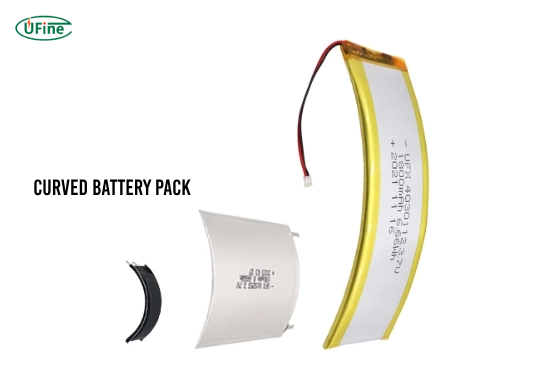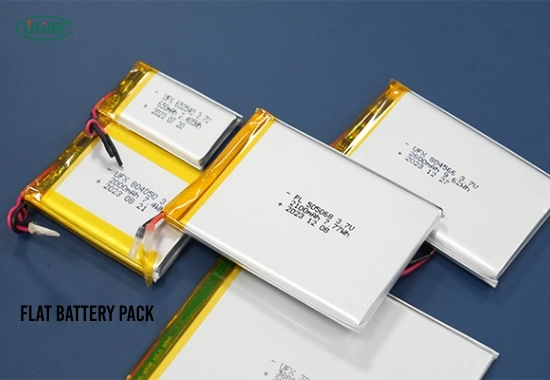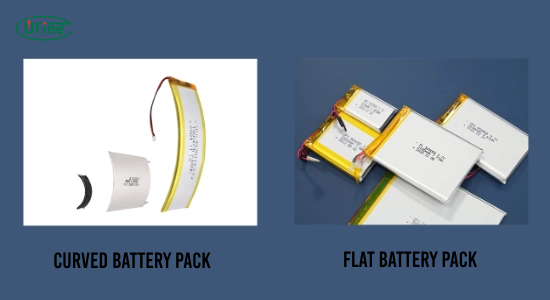
- Part 1. What is a curved battery pack?
- Part 2. What is a flat battery pack?
- Part 3. Key differences between curved and flat battery packs
- Part 4. Why are curved battery packs essential for flexible electronics?
- Part 5. Types of flexible materials used in curved battery packs
- Part 6. Pros and cons of curved battery packs
- Part 7. Pros and cons of flat battery packs
- Part 8. Which battery pack is better for wearables?
- Part 9. Battery life comparison: curved vs. flat
- Part 10. Future of battery technology in flexible electronics
- Part 11. FAQs about curved battery pack and flat battery pack
What is the difference between a curved battery pack and a flat battery pack? A curved battery pack is a flexible, shape-conforming energy storage unit designed for bendable or wearable electronics. In contrast, a flat battery pack is a rigid, traditional battery used in standard electronic devices. This article provides a detailed comparison between the two to help engineers, developers, and tech enthusiasts make the most informed choice for their specific applications.
With the rise of smartwatches, foldable phones, and wearable health monitoring devices, the need for flexible power sources has never been more critical. Understanding the strengths, weaknesses, and use cases of each battery type can lead to improved product performance and a better user experience.
Let’s explore this topic in depth.
Part 1. What is a curved battery pack?
A curved battery pack is a rechargeable power unit designed to maintain its performance even when bent, twisted, or curved. These batteries are designed to integrate seamlessly into flexible or wearable electronics that do not follow traditional flat surfaces.
Curved battery packs are typically built using soft or semi-rigid materials. Their design allows them to fit comfortably on the human body or inside flexible gadgets. Some of the most common applications include:
- Smartwatches and fitness bands
- Smart glasses
- Health monitoring wearables
- Foldable smartphones
- Smart clothing and e-textiles
These batteries are light, compact, and customizable in shape, allowing designers to focus more on ergonomics and user comfort.
Part 2. What is a flat battery pack?
A flat battery pack is the traditional lithium-ion or lithium-polymer battery used in most consumer electronics. These batteries have a hard, rectangular or square shape and cannot bend or flex during operation.
Flat battery packs are known for their high power capacity and cost efficiency. They are widely used in:
- Smartphones
- Tablets
- Laptops
- Power banks
- Remote controls
- Cameras
While flat batteries offer high energy density and efficient performance, they are not suitable for devices that require adaptability or flexibility in design.
Part 3. Key differences between curved and flat battery packs
Here is a data-driven comparison between curved and flat battery packs based on real-world specifications:
| Feature | Curved Battery Pack | Flat Battery Pack |
|---|---|---|
| Shape | Flexible or contoured | Rigid and flat |
| Thickness | 0.5 mm to 3 mm | 2 mm to 10 mm |
| Typical Capacity | 50 mAh to 300 mAh | 500 mAh to 5000 mAh |
| Energy Density | 80 to 150 Wh/kg | 180 to 250 Wh/kg |
| Cycle Life | 300 to 800 charge cycles | 500 to 1000 charge cycles |
| Operating Temperature | 0°C to 45°C | -10°C to 60°C |
| Weight | 1 to 15 grams | 20 to 100 grams |
| Production Cost | Higher | Lower |
| Customization Level | High | Medium |
| Use Case | Wearables, foldables | Phones, laptops, tablets |
Curved batteries trade off energy density for flexibility, while flat batteries optimize performance but lack adaptability in shape.
Part 4. Why are curved battery packs essential for flexible electronics?
Flexible electronics are the future of smart devices. From bendable displays to wearable health sensors, modern devices are being designed to adapt to human movement and non-flat surfaces. Curved battery packs are essential because they:
- Fit into unconventional shapes without compromising performance
- Enable thinner and lighter designs
- Improve user comfort in wearable products
- Support innovation in product form factors
Traditional flat batteries cannot accommodate these requirements. Without curved batteries, flexible electronics would be limited in both design and functionality.
Part 5. Types of flexible materials used in curved battery packs
The performance of a curved battery depends heavily on the materials used in its construction. Here are the key types of flexible materials utilized:
1. Flexible Substrates
These are the base layers on which battery components are mounted. Common materials include:
- Polyimide (PI): Offers excellent thermal stability and mechanical strength
- Polyethylene Terephthalate (PET): Lightweight, transparent, and cost-effective
- Thermoplastic Polyurethane (TPU): Adds flexibility and durability
2. Gel Electrolytes
Instead of using liquid electrolytes, curved batteries often use gel-based electrolytes, which are more stable and flexible. These allow for bending without leakage or short-circuiting.
3. Conductive Polymers
Materials like PEDOT:PSS or polyaniline are used to replace rigid metal electrodes. They provide flexibility while still conducting electricity efficiently.
4. Thin-Film Electrodes
Using nanomaterials such as graphene, carbon nanotubes, or silver nanowires, manufacturers can create ultra-thin, bendable electrodes that maintain conductivity even when curved.
5. Encapsulation Films
To protect the battery from external damage, flexible encapsulation films such as Parylene or polyurethane coatings are used to seal the battery components, allowing for movement.
These materials enable the production of batteries that are not only flexible but also safe, efficient, and long-lasting.
Part 6. Pros and cons of curved battery packs
Pros:
- Flexible design: Perfect for wearables and non-traditional form factors
- Lightweight and compact: Improves comfort in body-worn devices
- Safe under pressure: Designed to handle repeated bending
- Supports innovation: Enables new product types like smart textiles
Cons:
- Lower energy storage: Less capacity than flat batteries
- Higher cost: Expensive materials and manufacturing process
- Shorter lifespan: Fewer charge cycles on average
- Limited availability: Not as widely produced as flat cells
Part 7. Pros and cons of flat battery packs
Pros:
- High energy density: More power in less space
- Cost-effective: Cheaper to manufacture at scale
- Proven technology: Long history of use and reliability
- Easily available: Wide range of sizes and capacities
Cons:
- Rigid design: Cannot bend or flex
- Bulky in wearables: Not ergonomic for body-worn devices
- Limited design freedom: Restricts creativity in product shape
Part 8. Which battery pack is better for wearables?
Curved battery packs are better suited for wearable electronics. Their lightweight, contoured design makes them ideal for devices that are worn on the body. They improve comfort, reduce bulk, and allow for more natural product shapes.
Examples of where curved batteries excel:
- A smartwatch that wraps comfortably around the wrist
- A health tracker embedded in a fitness shirt
- A medical monitor placed behind the ear
Flat batteries cannot meet these ergonomic and design needs.
Part 9. Battery life comparison: curved vs. flat
Flat battery packs typically offer longer battery life due to their higher energy density and larger size. They can support power-hungry applications like smartphones and laptops for extended periods.
Curved battery packs, on the other hand, are designed for low-power, continuous-use scenarios. While they may not last as long on a single charge, they are often paired with energy-efficient chips and sensors in wearables.
Here’s a general comparison:
- Flat battery: 3000 mAh lasting 8 to 12 hours in a phone
- Curved battery: 150 mAh lasting 3 to 5 days in a fitness band
The difference comes down to use case rather than just longevity.
Part 10. Future of battery technology in flexible electronics
The future of flexible electronics depends heavily on advancements in battery technology. Some emerging trends include:
- Solid-state curved batteries: Offering better safety and energy density
- Graphene-enhanced batteries: For ultra-thin and highly flexible designs
- 3D-printed batteries: Allowing custom shapes on demand
- Self-healing materials: Extending battery life through automatic repairs
- Integration with solar textiles: Combining power generation and storage in clothing
As wearable and flexible devices continue to evolve, curved battery packs will become increasingly essential.
Part 11. FAQs about curved battery pack and flat battery pack
What are curved battery packs made of?
Curved battery packs are constructed with flexible substrates, such as polyimide, and utilize gel electrolytes, conductive polymers, and thin-film electrodes made from materials like graphene and carbon nanotubes.
Can a flat battery be replaced with a curved one?
No, curved and flat batteries are designed for different devices. Replacing one with the other would require a complete redesign of the device’s internal structure.
Are curved batteries safe for daily wear?
Yes, curved batteries are tested for flexibility, pressure, and temperature to ensure safety, especially in wearable applications.
Why are curved batteries more expensive?
They use advanced materials and custom manufacturing processes. Their limited production scale also contributes to the higher cost.
Do curved batteries support fast charging?
Some curved batteries support moderate-speed charging, but most prioritize safety and long cycle life over fast charging due to their smaller size.
Related Tags:
More Articles

Big Square Battery Safety Standards You Must Know
Learn key safety standards for big square batteries to avoid fire risks, shipping delays, and compliance issues in EV, industrial, and energy storage projects.
Big Square Battery Applications in Solar & Industrial Equipment
Big square batteries deliver high capacity, stable output, and long life for solar, industrial, and backup power. Explore key uses and advantages.
Big Square Battery vs Cylindrical Battery: Complete 2025 Guide for EVs, ESS & Industrial Devices
Choosing the right battery is key for designers and engineers. Compare big square vs cylindrical batteries to find the best fit for your application.
How to Choose the Right Big Square Battery for Your Device?
If you’re choosing a big square battery for EVs, solar, or mobility devices, this guide helps you pick the right solution for real-world needs.
Big Square Battery Complete Guide: Types, Uses & Buying Tips
If you are choosing a big square lithium battery for EVs, solar, RVs, or AGVs, this guide helps you select the right NMC, LFP, or LTO solution with examples.





